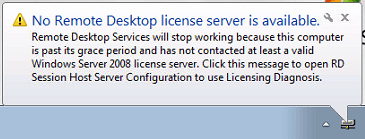Windows Server 2008 R2 Remote Desktop License Crack
This post will explain how to remove Remote Desktop Services Client Access Licenses.
I just got off the phone with Microsoft after wanting to remove some RDS CALs (Formerly known as TS CALs) from a Windows 2008 R2 Terminal Server (Now called Remote Desktop Server). After initially  looking this up, a Technet article mentioned needing to use the Remote Desktop Services Windows Management Instrumentation (WMI) provider. However clicking the link popped up a page stating that the document they refer you to was not available yet. (Not very helpful Technet). The other option in the Technet article mentioned deactivating the licensing server as another option. However when I tried this, followed by a reactivation of the licensing server, the old RDS CALs were still there.
This video is about how to remove concurrent sessions on Windows Server 2008 R2. This method is also applicable for Windows 7 Professional and Enterprise (tested). It doesn't matter Windows Domain.
- Windows 2008 R2 Remote Desktop License Server. Windows Server >. The issue, it appears, has more to due with the security of Windows 2008 R2 more then the RD Licensing technology.
- “The Remote Desktop Session Host server is in Per User licensing mode and No Redirector Mode, but license server “server name” does not have any installed licenses with the following attributes: Product version: Windows Server 2008 or Windows Server 2008 R2. Licensing mode: Per User. License type: RDS CALs”.
So to get this done here is the process we followed:
1. Open the RD Licensing Manager.
2. Select the Server name, right-click it and then choose Properties. Switch connection method to Telephone and choose your Country. Note – if you want you could also use Internet as connection manager. I did Telephone as I had a guy from the Clearing House / Licensing department on the line already. Click OK to confirm.

3a. Right-click the server name again, go to Advanced, then choose “Deactivate Server”. Run through the wizard. With telephone selected I had to read out a deactivation number. The consultant then read out a confirming code that I entered into the wizard. After this I finished the Wizard which deactivated the Licensing.
b. Next, re-activate the License server – right-click the server name, select Activate, read out the codes in the wizard and enter the key they give back to you. (Or just use the Internet activate method). I needed to close the RD Licensing console at this stage.
4. So next up I launched the Services console (Start -> Run, type services.msc and click OK). Go down to Remote Desktop Licensing, right-click it and choose “Stop” to stop the service.

Server 2008 R2 License Key
5. Navigate to C:WindowsSystem32lserver and look for the “TLSLic.edb” file. Delete this file. (I would make a backup just in case you wanted it back for some reason).
6. Start the Remote Desktop Licensing service again. (Right-click service and choose “Start”).
7. The Service should start correctly.
8. Launch the RD Licensing console again (you should have closed it at the end of step 3). Your previous licenses should be gone now.
9. Right-click the server and choose “Install Licenses”. Go through the wizard to get the correct RDS CALs installed. You won’t be violating any Microsoft licensing agreements because you deleted your previous RDS CALs. Once everything is working again, delete your backup of your old RDS CALs (the .EDB file that you backed up).
That is it. You should now have removed your old RDS CALs and installed new RDS CALs. Note that no users will be able to login to this RDSH server whilst there are no CALs in place, so do this as planned down time.

Remote Desktop Windows Server 2008
#1: Remote Desktop Services | ||
| You say tomato, we say Terminal Services. The name change with R2 is appropriate considering RDS' big bang feature – Remote Desktop Virtualization. In fact, pretty much nothing is known by the same name anymore (even a Terminal Server is now called a Remote Desktop Session Host). Enough with the redubs, though. Built on a VDI infrastructure, RDS brings with it a host of enhancements like fair share CPU scheduling and the Remote Desktop Connection Broker. There's a lot more, too (but we just don't have the space to list them all). -- Disagree with our top 10? Let us know which key feature you think we missed.
|